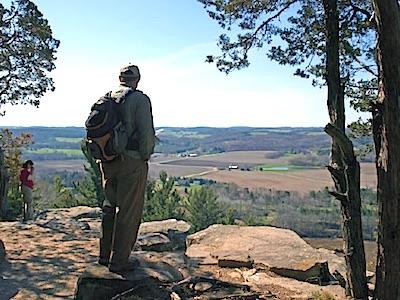
The Ice Age National Scenic Trail holds a geologic primer in the landscapes it traverses/Ice Age Trail Alliance
Fall, which is arguably the best season for hiking in the National Park System, is almost upon us. The cool days and bright colors provide hikers with plenty of incentive to hit the trails.
With that wonderful season in mind, we’ve selected some of the country’s “scenic trails” for your consideration. To those we’ve added a Yellowstone National Park classic, a hike in Canyonlands National Park, and another that traces one of the bloodiest days of the Civil War.
Here's our first hike for this fall:
Ranging almost 1,200 miles across Wisconsin, the Ice Age National Scenic Trail has a strong local following, and for just that reason alone you should add it to your list. After all, locals know what's best in their backyard, right?
Running from Interstate State Park on the St. Croix River in western Wisconsin to Potawatomi State Park near Green Bay, the trail winds through thick forests and past the geologic wonders of kames, lakes, drumlins, eskers, and other landforms created during the last ice age 10,000 years ago.
“Near the end of the Wisconsin Glaciation, a series of ridges formed between two immense lobes of glacial ice in what is now southeastern Wisconsin,” notes the Ice Age Trail Alliance on its website. "These ridges are 120 miles long, and scattered among them are crater-like depressions that were created by large chunks of melting ice.
“Geologists named this region the Kettle Moraine,” it goes on. “Studies that began in the Kettle Moraine during the 1870s led to key discoveries and the first map of the extent of continental glaciation in North America.”
A consortium of agencies oversees the trail, from the National Park Service to the state of Wisconsin and local government entities. Some sections of the trail run across private property, so respect those landowners’ rights.
To find the best information on the trail, head to the Ice Age Trail Alliance’s website. There you’ll see valuable resources ranging from the Ice Age Trail Guidebook 2014 and the Ice Age Trail Atlas 2014 to a spreadsheet of waypoints and list of recommended hikes.
Turn to the Alliance’s suggested backpacking trips and you’ll find options ranging from 21-mile to 40-mile hikes. The PDFs provide snapshots of the details of each trip, complete with maps, camping options, and highlights. Here’s a snippet from the Chequamegon National Forest Backpacking Guidebook:
“North of Forest Road 558, the segment continues to make its way northeast toward Lake Eleven on dramatic high-relief hummocky topography through a mix of conifers and hardwoods. Hikers can experience a true remote feeling in this area. The segment highlights a classic icewalled lake plain as it passes by the south shore of a small pond, roughly a half-mile west of the Sawyer Avenue crossing. Beaver dams are in ponds, creeks, bogs and marshes. Boardwalks are well placed, but some traversing of bogs and wet crossings is required. This area is full of logging history; logging railroads penetrated the interior lands between the rivers around 1890.”
If you like hiking but not sleeping on the ground, you might even be able to piece together an itinerary that ends each day at a bed-and-breakfast, conveniently located near the trail. There’s a listing on the alliance’s website.
Helpful books:
Ice Age Trail Guidebook, by the Ice Age Trail Alliance
Ice Age Trail Atlas, by the Ice Age Trail Alliance
Along Wisconsin’s Ice Age Trail, a photographic overview of the trail by Bart Smith

 Support Essential Coverage of Essential Places
Support Essential Coverage of Essential Places







Comments
We love the Ice Age Trail.
It's a great trail but still a long way from being complete so every bit of support helps. Thanks for including it Kurt. And happy belated anniversary. You run a great site.